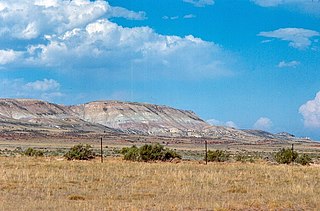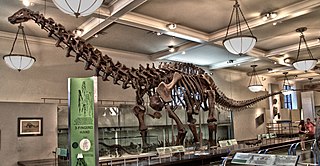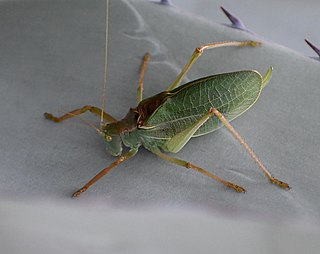
Apatosaurus is a genus of herbivorous sauropod dinosaur that lived in North America during the Late Jurassic period. Othniel Charles Marsh described and named the first-known species, A. ajax, in 1877, and a second species, A. louisae, was discovered and named by William H. Holland in 1916. Apatosaurus lived about 152 to 151 million years ago (mya), during the late Kimmeridgian to early Tithonian age, and are now known from fossils in the Morrison Formation of modern-day Colorado, Oklahoma, New Mexico, Wyoming, and Utah in the United States. Apatosaurus had an average length of 21–23 m (69–75 ft), and an average mass of 16.4–22.4 t. A few specimens indicate a maximum length of 11–30% greater than average and a mass of approximately 33 t.

Alectryon excelsus, commonly known as tītoki, or sometimes New Zealand oak, is a shiny-leaved tree native to New Zealand. It is in the family Sapindaceae. It lives in coastal and lowland forests throughout most of the North Island and from Banks Peninsula to central Westland in the South Island.

Como Bluff is a long ridge extending east–west, located between the towns of Rock River and Medicine Bow, Wyoming. The ridge is an anticline, formed as a result of compressional geological folding. Three geological formations, the Sundance, the Morrison, and the Cloverly Formations, containing fossil remains from the Late Jurassic of the Mesozoic Era are exposed.

Brontosaurus is a genus of herbivorous sauropod dinosaur that lived in present-day United States during the Late Jurassic period. It was described by American paleontologist Othniel Charles Marsh in 1879, the type species being dubbed B. excelsus, based on a partial skeleton lacking a skull found in Como Bluff, Wyoming. In subsequent years, two more species of Brontosaurus were named: B. parvus in 1902 and B. yahnahpin in 1994. Brontosaurus lived about 156 to 146 million years ago (mya) during the Kimmeridgian and Tithonian ages in the Morrison Formation of what is now Utah and Wyoming. For decades, the animal was thought to have been a taxonomic synonym of its close relative Apatosaurus, but a 2015 study by Emmanuel Tschopp and colleagues found it to be distinct. It has seen widespread representation in popular culture, being the archetypal "long-necked" dinosaur in general media.

Orites excelsus, commonly known as prickly ash, mountain silky oak or white beefwood, is a species of flowering plant in the family Proteaceae and is endemic to eastern Australia. It is a medium-sized to tall rainforest tree with oblong to lance-shaped leaves, variously lobed and with teeth on the edges. The flowers are white and arranged in leaf axils in spikes that are shorter than the leaves.

Amblyseius is a large genus of predatory mites belonging to the family Phytoseiidae. Many members of this genus feed on other mites such as red spider mites, and also on thrips. Several species are popular as biological control agents to control these pests.

The moustached kingfisher, also called Bougainville moustached kingfisher, is a species of bird in the family Alcedinidae. It is endemic to Bougainville Island in Papua New Guinea. An estimated 250–1,000 mature individuals are left.

The Chinese highland shrew is a species of shrew in the family Soricidae. It is found in China.

Apatosaurinae is a subfamily of diplodocid sauropods, an extinct group of large, quadrupedal dinosaurs, the other subfamily in Diplodocidae being Diplodocinae. Apatosaurines are distinguished by their more robust, stocky builds and shorter necks proportionally to the rest of their bodies. Several fairly complete specimens are known, giving a comprehensive view of apatosaurine anatomy.

Conus excelsus, commonly known as the excelsior cone or illustrious cone, is a species of predatory sea snail, a marine gastropod mollusk in the family Conidae, the cone snails.

Craterellus excelsus is a species of fungus in the family Cantharellaceae. Reported as a new species in 2009, it was originally collected from the Pakaraima Mountains of Guyana. The species is found in rainforests that are composed predominantly of Dicymbe species. C. excelsus has fruit bodies that may be up to 15 cm (6 in) in height and grow in dense clusters.
Amblyseius andersoni is a species of mite in the family Phytoseiidae. It is found in Europe.
Amblyseius fieldsi is a species of mite in the family Phytoseiidae.

Amblyseius tamatavensis is a species of mite in the family Phytoseiidae.
Afrogarypus is a genus of pseudoscorpions, which contains the following species:
Typhlodromips swirskii, the Swirski mite, is a species of predatory mite in the family Phytoseiidae. It is used in biological pest control of western flower thrips in greenhouse or indoor grown crops.
Notiohyphantes excelsus is a species of spiders in the family Linyphiidae. It is found from Mexico to Peru, Brazil and on the Galapagos Islands.

Paracyrtophyllus excelsus, known generally as the chisos katydid or big bend quonker, is a species of true katydid in the family Tettigoniidae. It is found in North America.












